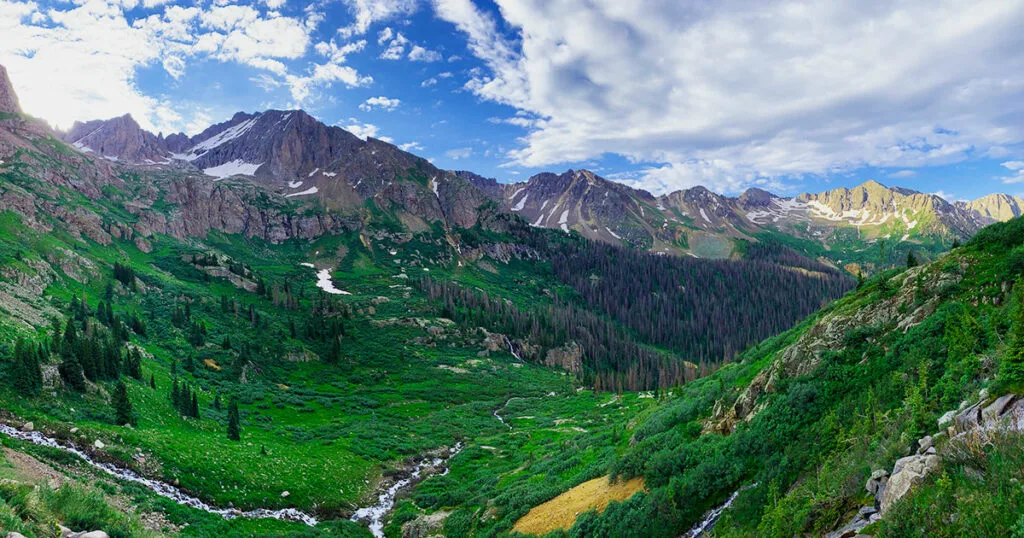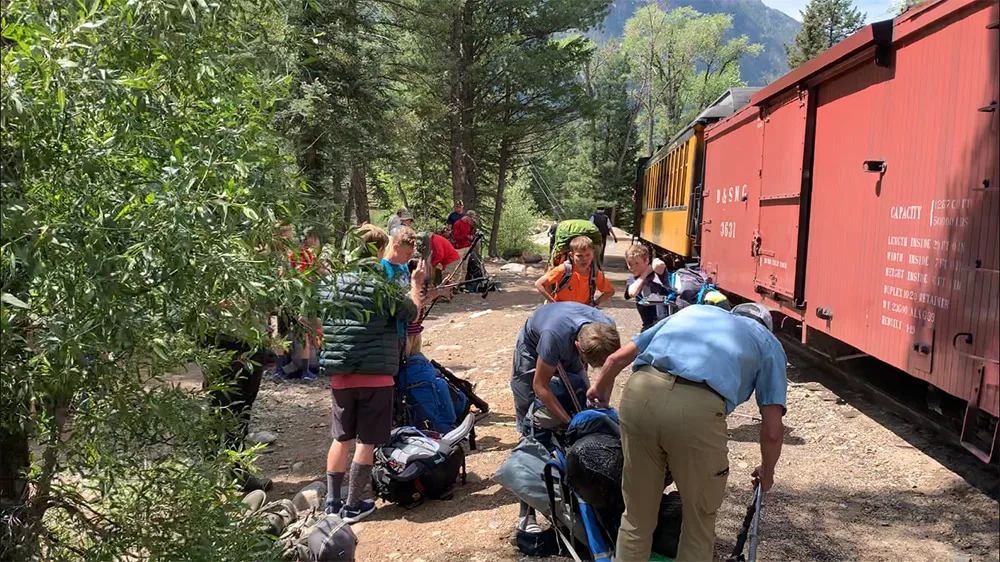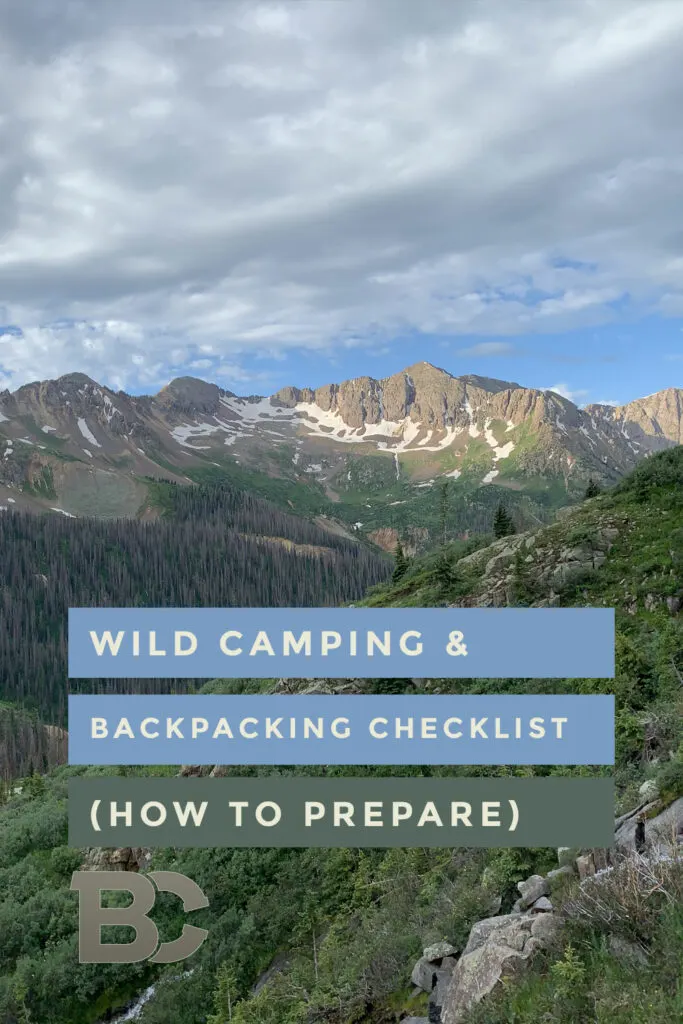Far away from conveniences, deep into adventure, fresh cool air, vast mountain views… that’s wild camping. You and only the gear you carry on your back.
This is your guide and checklist: preparing for your wild camping, backpacking trip.

This post is your guide on prepping for a wild camping, backpacking adventure.
Experience Backpacking
Backpacking is my preferred camping method. There’s a level of difficulty with backpacking that excludes a majority of the public. You’ve got to be fit, you’ve got to plan (otherwise it might not be much fun). Getting deep into the backcountry away from the crowds provides a bond between you and nature. It’s a great way to recenter your life and feel accomplished.

Backpacking requires preparation, more so than other camping methods. You’ve got to carry everything with you and if you forget something, too bad. Getting your backpacking checklist accurate and lightweight is priority number 2.
What’s priority number 1 when it comes to backpacking?
Your level of fitness. For a more favorable adventure, being physically prepared is essential. Here in Colorado, most of my backpacking adventures are around 9,000 to 11,000 feet above sea level. If you’re not ready for the altitude, that too may crush your spirits.
We’ll get into fitness preparation but first, your backpacking checklist:
Backpacking Gear Checklist
Let’s take a look at backpacking priority number 2: GEAR (your backpacking checklist). I’ve created a complete camping essentials post with all of my favorite gear, there’s a backpacking gear guide that’ll help you prepare.
Here’s a simplified list of items you’ll want on your next backpacking trip:
- Rugged Backpack (fit to your body size) – check out an External Frame Backpack
- Food (lightweight – freeze dried is a good option – plan your days – plan for snacks)
- Very small backpacking stove with heat source (gas) to heat water (for freeze dried food)
- Utensil to eat freeze dried food out of bag
- Water Filter / Purification
- Water bottles / reserves
- Headlamp
- First aid kit
- Rain gear (not a must have – it’s nice to have if it rains)
- Hiking Boots
- Quality Wool Socks
- Clothing including hiking pants (no jeans)
- Shorts (even if it’s cool, you’ll want shorts)
- Sweatpants for sleeping
- Warm clothing (for cold nights) – ie beanie + jacket
- Tent or sleeping hammock
- Sleeping bag or blanket / pillow
- Pocket knife
- Small poo shovel
- Toilet paper
- Camp Flip flops
- Sunglasses
- Flint and steel
- Extra batteries for headlamp
- Toothbrush and toothpaste
- Large ziplock bags for trash
- Insect Repellant
The camping essentials gear guide includes my top picks for camping gear.
Wild Camping & Backpacking Fitness Prep
Leading up to your adventure into the backcountry, it’s a good idea to properly train your body. Here are a few tips on how to train for backcountry, backpacking adventure.
Train the Legs w/ Lunges, Deadlifts, and Squats
It’s a good idea to focus on your leg strength for all of the steps you’ll be taking, the elevation gain, and pivoting around rocks. Strong legs and a strong core make a difference when carrying a pack.
Find a program that focuses heavily on these 3 movements: Lunges, Deadlifts, and Squats. HIIT (high intensity interval training) or Crossfit are great options for training prior to backpacking. Transitioning between movements during a workout with an added run mixed in is a great idea.
Here’s an example of a workout for prepping for backpacking adventure. This workout is called an AMRAP which stands for As Many Rounds as Possible. Do as many rounds as possible in 20 minutes of:
- 10 Air Squats (that’s a squat with no weight)
- 10 Lunges (5 each leg)
- 10 Deadlifts (if you have a bar and weight)
- Run to a mark outside and back (try to make the run there and back less than 1 minute)
That’s one example of a workout you can do at home to help train for your backpacking, wild camping adventure.
Train the Shoulders & Pack Training
You’ll notice that your neck, shoulders, and possibly your lower back, when carrying a heavy pack, start to fatigue quickly and it’s a feeling that you may not be used to. The best method in preparing your shoulders is to put on the pack, load it 2X what the weight will be when camping (use sand bags or weights) and go on a hike, often.
This method will help you build up a tolerance to heavier weight and will help you realize the impact your pack will have on your posterior side.
In addition to carrying a heavy pack to train, you’ll want to include a few movements in your workout routine. You can include these in your HIIT workouts (like we discussed earlier).
- Pull Ups
- Strict Press
- DB Lateral Raise
- GHD Situps
An example workout including these and the lower body training discussed above:
AMRAP (as many rounds as possible) in 20min
- 10 Lunges (5 each leg)
- 10 Pull Ups
- 10 GHD Sit Ups
- 10 Squats
- Run to a mark outside and back (try to make the run there an back less than 1 minute)
Create a fun mix of different movements and keep to a schedule, the easier your workouts get the more likely you’ll enjoy your backpacking trip. If you’re doing 20 min AMRAP workouts, try to get in 4 or 5 per week leading up to your trip. Mix up the movements and go as hard as you can.


Allan Walsh
Saturday 19th of November 2022
I’m so glad to find this packing list. I completely forget about important things when I’m packing for a trip and this article is a great reminder, now I know what to bring with me the next time! Thankss!